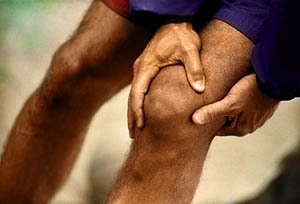 Osteoarthritis of the knee joint( sometimes also called gonarthrosis) is a degenerative disease that manifests itself in the damage to the joint structures and leads to deformation and, ultimately, complete loss of mobility in the knee.
Osteoarthritis of the knee joint( sometimes also called gonarthrosis) is a degenerative disease that manifests itself in the damage to the joint structures and leads to deformation and, ultimately, complete loss of mobility in the knee.
Unfortunately, this disease is quite common and according to statistics, up to 30% of the world's population suffer from osteoarthritis of the knee joint of one degree or another. The disease is chronic and can be accompanied by inflammatory processes.
The peculiarity of this disease is that the problem identified at early stages can be effectively treated, and a person will live a life full of movements for a very long time. There is another side to the coin: since the disease is chronic, it will not be completely erased. Treatment only slows down the process of wear and tear of the joint, but this will be enough for a full life.
Ignoring the problem can lead not only to soreness, restrictions in movement, but also to a complete loss of joint functionality due to wear of the cartilaginous tissue in the knee.
Contents of the article
- The provoking factors
- The symptoms of the disease
- The stages of development and their symptoms
- The diagnosis of
- The complex of therapeutic measures
- Traditional medicine
- Complications and prevention
The provoking factors
The causes that cause the development of knee osteoarthritis:
- Age .The disease affects up to 85% of the world's population older than 60 - 65 years. At this age, cartilaginous tissue can no longer be restored, so the age-related changes and aging of the organism as a whole cover all structures, including joints. Even small loads at this age can have a devastating effect on the cartilage tissue of the knee.
- High load .In this group of people, those occupations that are associated with excessive physical burden of
 : athletes, loaders, and many others fall into this risk group.
: athletes, loaders, and many others fall into this risk group. - Overweight .In this case, arthrosis develops in two cases: obesity, as a result of problems with metabolism and the hormonal balance, or purely physical stress on the knees due to excessive weight of a person. In the latter case, it is on the feet, and more specifically, the knees are the main load, which leads to the destruction of cartilaginous tissue. According to statistics, the greatest percentage of the disease falls on women after 40 years of overweight. Thus, the disease with arthrosis is 4 times more common in full than in people with normal weight. And, accordingly, the more weight, the stronger the destructive force acts on the knee joints.
- Diseases, injuries, surgical interventions .Any intervention in knee joints: whether surgery or previous injuries can lead to arthrosis. This problem can cause a violation of blood circulation, a violation of hormonal adjustment( during pregnancy).
- Stresses .Stressful situations that arise in a person's life, lead to muscle spasm and the development of a stress hormone, and this, in turn, leads to the development of arthrosis.
- Heredity, congenital nature of the disease .Clients of orthopedic clinics, in most cases, are people of the age, but nevertheless there are situations when young people become patients. In this case, we can talk about the hereditary nature of the disease. It can also be a congenital pathology associated with an insufficient amount of intraarticular lubrication.
Symptoms of the disease
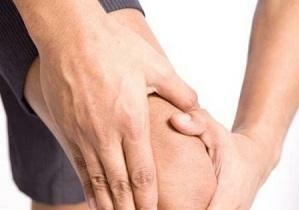 Naturally, the diagnosis should be made by the attending physician, but in order to seek help, you need to know the main symptoms that indicate the development of deforming osteoarthritis of the knee joint.
Naturally, the diagnosis should be made by the attending physician, but in order to seek help, you need to know the main symptoms that indicate the development of deforming osteoarthritis of the knee joint.
This will help in time to seek medical help and not miss the moment in order to begin treatment in time to maintain and maintain the normal joint and its cartilaginous tissue.
So, for the development of osteoarthritis may indicate such signs:
- suddenly soreness of knee joints can not arise, therefore initially in a problem place there will be discomfort and unpleasant sensations;
- may further develop painful sensations, which are accompanied by stiffness in the joint and limited movements;
- if you ignore treatment and if you do not seek qualified medical help, the joint is completely immobilized;
- traces muscle atrophy;
- there is a rough crunch in the knee joint;
- there are sensations of podkashivaniya legs;
- valgus( X-shaped) or varus( O-shaped) deformation of joints occurs in 50% of cases.
But that's not all, since the launched osteoarthritis of the knee joint of 2nd and 3rd degree may be accompanied by some other symptoms:
- pinching of the meniscus: thus, any movement is accompanied by severe pain and impossible attempts to bend and unbend the knee;
- occurrence of sudden internal bleeding in the joint ( hemarthrosis);
- inflammatory processes of the synovium : characterized by local temperature increase, edema, fluid appearance and joint enlargement;
- osteonecrosis of the femur ( bone segment can be separated).
Stages of development and their symptoms
Each stage of arthrosis is accompanied by characteristic symptoms. Thus, in medicine, three degrees of osteoarthritis of the knee joint are distinguished.
The first stage is characterized by the following symptoms:
- , fatigue of the legs occurs quickly;
- with pain increases;
- because of painfulness, the amplitude of movements decreases;
- after the load, there is discomfort in the knee.
In the pictures of the 1st stage of the disease development, it is possible to observe the narrowing of the joint cavity( so far insignificant).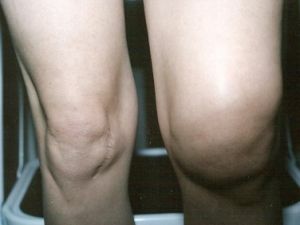
The second stage is characterized by the following manifestations:
- discomfort is felt constantly, even if the person is at rest, including after rest in the morning;
- gait becomes slow due to constant painful sensations, stiffness of movements, subsequent deformation of the joint, which leads to inflammatory processes and the appearance of edema.
In the pictures of the second stage, there will be a significant narrowing of the joint cavity, bone proliferation, bone thickening. It is at this stage, often, that patients seek medical help.
3 the severity of the disease is the heaviest, which can not be cured. A patient with osteoarthritis of the knee joint of the third degree receives a disability. To correct a situation at this stage it is possible only by implantation of an artificial joint.

Diagnosis of
As a rule, a person, having found the symptoms of knee joint destruction, goes to the reception not to a narrow specialist - an orthopedist, but to a surgeon or therapist. But even these specialists will prescribe the necessary minimum of studies, with the results of which it is necessary to go to the orthopedist's office:
- General blood test : here an important indicator for the specialist will be ESR.If it exceeds 20 mm, there is every reason to suspect the inflammatory processes that occur in the knee joint.
- Biochemical blood test : about inflammatory processes here will speak indicators of alkaline phosphatase, sialic acids, seromucoid, rheumatoid factor.
- Radiography in two projections of : often, to determine the diagnosis and establish the stage of one this study will be enough. Minus radiography is only that the condition of the soft tissues of the joint can not be evaluated.

After these mandatory examinations, the orthopedist can add a few more points to confirm or clarify the diagnosis:
- USD : allows to evaluate the condition of soft tissues. The only negative: only a specialist with extensive experience in this field and this research can really assess the condition of tissues, since practice in this case plays a key role.
- MRI : The study is more expensive than ultrasound, but it allows an unmistakable assessment of the condition of the meniscus, capsule, cartilage, ligaments on a variety of slices.
Complex of therapeutic measures
Treatment of osteoarthritis of the knee joint( if its cause is known precisely) is directed, first of all, to getting rid of the provoking factor.
If the disease develops as a result of a metabolic disorder, it is necessary to use a diet and bake the food back to normal. If the cause of the disease is overweight, it must be discarded. To treat a disease that has arisen against the backdrop of hard work is necessary only after changing jobs to more sparing.
The medical treatment of knee osteoarthritis occurs through the use of several groups of drugs:
- analgesics ( anesthetize joints);
- chondroprotectors ( substances that enter the body, nourish and repair cartilage tissue);
- drugs that improve blood circulation ;
- anti-inflammatory drugs ( hormonal or non-steroidal).
To achieve the effect, medical therapy should be supported by some other methods: 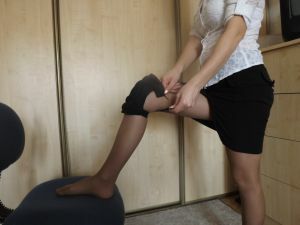
- massage courses of shin and hip massage( 2-3 times per year);
- therapeutic exercise aimed at preventing contractures;
- with loads use a knee-restraint and orthopedic shoes;
- physiotherapy( UHF, ultrasound, laser, amplipulse);
- acupuncture;
- surgical treatment.
Traditional medicine
At home, treatment of osteoarthritis can be maintained and strengthened with the help of folk remedies and methods.
Decoctions for ingestion:
- tea with ginger will help to remove inflammatory processes and eliminate pain syndrome;
- before taking food should take a decoction of willow bark, birch, nettle, calendula in equal parts;
- for half a glass on an empty stomach take a decoction of the husks of onions and dandelion leaves;
- soreness will help reduce the broth of dogrose.
Compresses:
- Application from crushed fresh horseradish , brewed in warm water.
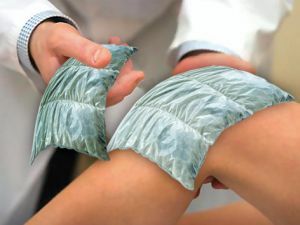
- compress made of blue clay mixed with crushed leaves of fresh burdock( the product must be warm) is applied for several hours on the knee. Next, the application is fixed with a bandage: you can take a warm scarf.
- Fresh alcohol from the dandelion insists on alcohol. Keep the product in a dark place for at least two weeks. After that several times a day, the remedy is rubbed into the problem site.
- An ointment, prepared from a glass of salt( large) and a glass of mustard , is rubbed into the diseased joint before going to sleep .For better consistency, warm paraffin is added.
Well proven in the treatment of arthrosis of the knee joint bath with sea salt and turpentine. Such a composition helps to get rid of painful sensations and inflammatory processes, while restoring the motor function to the aching joint.
Complications and Prevention
A neglected disease is fraught with not only increased pain, which simply does not allow you to perform everyday tasks and lead a normal life, but, in the end, can lead to disability( complete immobilization of the knee joint).
In order to reduce the likelihood of developing osteoarthritis, you need to monitor your weight and lifestyle. Do not wear weights and overload your legs.
It is important to perform simple physical exercises that are not aimed at the knee joint - this will strengthen the body and its resistance to various kinds of diseases. This prevention should be supported by folk methods in the form of broths, ointments and baths, which will reinforce the effect.



